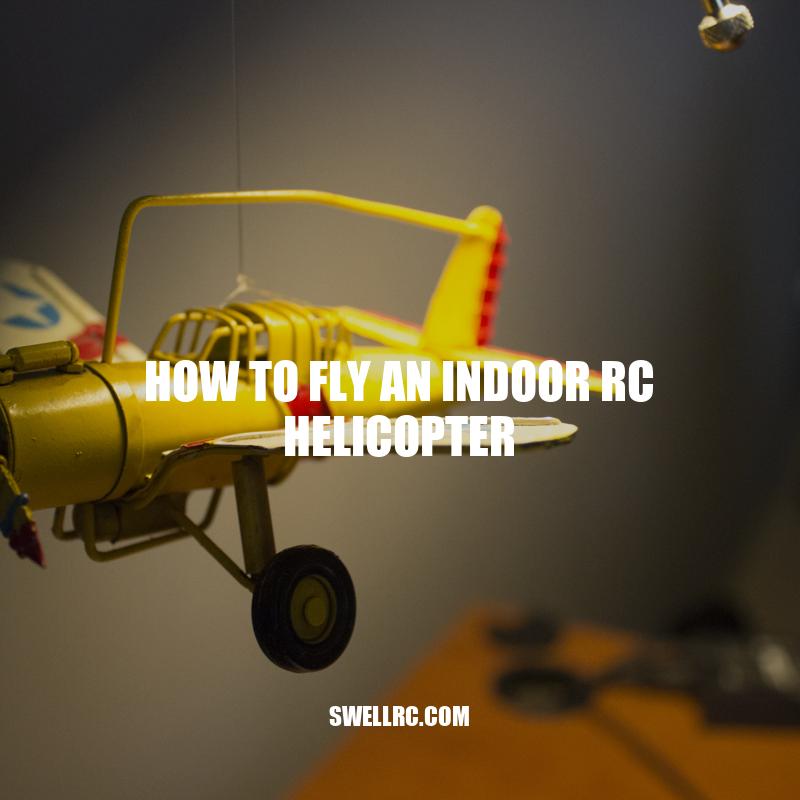How to Fly an Indoor RC Helicopter: A Beginner’s Guide
Flying an indoor RC helicopter can be a fun and rewarding hobby for enthusiasts of all ages. It offers a unique way to experience the thrill of flight and the satisfaction of mastering new skills. However, before taking to the skies, it’s important to have a good understanding of the basics of flying an indoor RC helicopter. This includes choosing the right helicopter, conducting a pre-flight check, understanding the basic controls, and mastering takeoffs and landings. With practice and patience, even beginners can learn to fly an indoor RC helicopter with confidence and skill. Additionally, the ability to perform advanced maneuvers builds on the basics and takes flying to the next level. While flying an indoor RC helicopter can be a thrilling experience, it’s important to prioritize safety at all times and to ensure that you have the necessary equipment and knowledge to fly responsibly. In this article, we’ll explore the essentials of how to fly an indoor RC helicopter, from selecting the right helicopter to performing advanced maneuvers, so that you can take to the skies with confidence.
Choosing the Right Helicopter
Choosing the right indoor RC helicopter is the first step to becoming a skilled pilot. Here are some factors to consider when choosing a model:
- Experience level: If you are a beginner, start with a simple, easy-to-use helicopter designed for new pilots. More advanced models will have a steeper learning curve and require more skill and experience to fly.
- In-door or outdoor: Choose a helicopter that is designed for indoor use. Outdoor models have a different design and will not perform as well in confined spaces.
- Type of helicopter: There are different types of indoor RC helicopters, including the coaxial helicopter, the fixed pitch helicopter, and the collective pitch helicopter. Select a type that suits your skill level and flying style.
- Brand reputation: Choose a reputable brand that has a proven track record of producing high-quality RC helicopters. Some popular brands include Blade, Syma, and WLtoys.
- Price: While it’s tempting to go for cheaper models, investing in a higher quality helicopter will ensure a better flying experience and will likely be more durable in the long run.
There are many indoor RC helicopter options on the market, so be sure to do your research and read reviews before making a purchase.
What skills do you need to fly a helicopter?
To fly a helicopter, you need a combination of technical skills, physical skills, and cognitive skills. Here are some of the abilities required:
- Excellent hand-eye coordination and motor skills to manipulate the flight controls and perform delicate maneuvers
- A deep understanding of aerodynamics, electrical systems and navigation principles
- Sound judgment and quick decision making skills under high-pressure situations
- Strong communication skills to converse with ground control, passengers, and other aircraft
- The ability to multitask and process multiple streams of information simultaneously
- Good physical endurance and mental resilience to handle long flights and periods of inactivity
It’s important to undergo formal helicopter pilot training to learn these skills and be licensed to fly. Visit websites like faa.gov for more information on pilot licensing requirements and training programs.
Pre-Flight Check
Before taking flight, it’s important to conduct a pre-flight check to ensure your indoor RC helicopter is in good working condition. Here are some steps to take:
| Step | Check |
| 1 | Batteries |
| 2 | Rotors |
| 3 | Remote control |
| 4 | Electronics |
| 5 | Stability |
Step 1: Batteries
Check that your helicopter and remote control have fully charged batteries.
Step 2: Rotors
Ensure that the rotor blades are in good condition, free from damage, and correctly attached.
Step 3: Remote Control
Check that the remote control is working correctly and that calibration is correct.
Step 4: Electronics
Inspect the electronic components of the helicopter, such as the receiver and electronic speed controller, for any damage.
Step 5: Stability
Ensure that the helicopter is stable and that there is no visible damage or loose parts.
Taking the time to conduct a thorough pre-flight check can help prevent crashes or accidents during your flight.
How do you fly a helicopter remote?
To fly a helicopter remotely, follow these steps:
- Read the user manual carefully.
- Ensure the battery is charged and the remote is turned on.
- Use the left stick to control altitude and rotation, and the right stick to control direction and speed.
- Make small adjustments to the sticks to prevent sudden movements.
- Practice in an open area away from obstacles or people.
There are many different types and models of remote-controlled helicopters available. Some popular brands include Syma and Blade. For more information and tips on flying remote-controlled helicopters, check out websites such as RCGroups.com or RCHelicopterFun.com.
Basic Controls
To control your indoor RC helicopter, you need to master the basic controls. Here are the three main controls:
| Control | Description |
| Throttle | Controls the up and down movement of the helicopter |
| Elevator | Controls the forward and backward movement of the helicopter |
| Ailerons | Controls the left and right movement of the helicopter |
Throttle
– Used to increase or decrease the engine power
– Increase throttle to take off
– Decrease throttle to land
Elevator
– Used to control the pitch of the helicopter
– Pull the elevator to move forward
– Push the elevator to move backward
Ailerons
– Used to control the roll of the helicopter
– Move the ailerons to the left to turn left
– Move the ailerons to the right to turn right
It’s important to master the basic controls before attempting more advanced maneuvers. Practice flying your helicopter up and down, forward and backward, and left and right until you feel comfortable with all three controls. Some indoor RC helicopter manufacturers offer online videos and tutorials to help beginners master the basic controls. You can check out the Blade Helis website for more information on their products.
What Controls Up and Down on Helicopter?
- The main rotor blades control lift and provide the upward force needed for the helicopter to take off and stay aloft.
- The rear rotor or tail rotor controls the pitch of the helicopter’s nose and prevents it from spinning uncontrollably.
- The cyclic pitch control allows the helicopter to move forward, backward, left, and right by changing the angle of the rotor blades in different directions while in-flight.
- The collective pitch control modulates the angle and pitch of all blades together in order to control the altitude of the helicopter.
For more information on helicopters, check out websites such as Vertical Magazine and The Helicopter Association International. If you’re interested in a fun and informative helicopter tour, check out Maverick Helicopters for unique experiences in multiple locations.
Taking Off and Landing
Taking off and landing an indoor RC helicopter is critical to flying it safely. Here are the steps to take when taking off and landing your helicopter:
Taking Off
- Place the helicopter on a flat surface
- Increase the throttle to lift the helicopter off the ground
- Keep the helicopter steady and level until it’s at a comfortable height
Landing
- Slowly decrease the throttle to lower the helicopter to the ground
- Make sure to land the helicopter gently to avoid damage
Practice taking off and landing your indoor RC helicopter until you feel comfortable with each maneuver. Start with small takeoffs and landings and gradually increase their size and complexity. Some indoor RC helicopter manufacturers offer landing training kits that help beginners practice landing their helicopters safely.
Remember to take your time and not rush the process. Taking off too quickly or landing too hard can damage your indoor RC helicopter.
Are RC helicopters hard to fly?
Flying an RC helicopter can be challenging, but with practice and perseverance, it can be mastered. Here are some things to keep in mind:
- RC helicopters have multiple channels that control different movements, which can take time to learn
- It’s important to start with a beginner-friendly model and gradually work your way up to more advanced ones
- Weather conditions, especially wind, can affect the flight and make it more difficult
- Proper maintenance and care is necessary to keep the helicopter in good condition
There are many resources, such as instructional videos or forums, available online for those looking to learn more about flying RC helicopters. Additionally, some companies offer beginner-friendly models with features that make it easier to fly, such as stabilization systems or altitude hold.
Advanced Maneuvers
Once you have mastered the basic controls and feel comfortable with taking off and landing your indoor RC helicopter, it’s time to try some advanced maneuvers. Here are a few tricks you can try:
Hovering
- Lift the helicopter straight up to a comfortable height
- Push the joystick forward to move the helicopter forward
- Pull the joystick back to move the helicopter back
- Move the joystick left or right to spin the helicopter in that direction
Figure Eight
- Lift the helicopter straight up to a comfortable height
- Fly the helicopter forward in a straight line
- Turn the helicopter left, moving in a circular motion
- Fly the helicopter back to its starting position
- Turn the helicopter right, moving in a circular motion
- Fly the helicopter back to its starting position
Flips and Rolls
- Lift the helicopter straight up to a comfortable height
- Push the joystick forward and then quickly back to perform a front flip
- Pull the joystick back and then quickly forward to do a backflip
- Push the joystick to the left or right to roll the helicopter in the corresponding direction
Be sure to practice these advanced maneuvers in a safe and controlled environment, and give yourself plenty of room to maneuver. Some indoor RC helicopter manufacturers offer video tutorials and training exercises for advanced maneuvers, so be sure to check out their websites for more information.
How do you change the direction of a helicopter?
To change the direction of a helicopter, the pilot needs to adjust the pitch of the rotor blades. This changes the amount of lift generated by each blade, causing the helicopter to tilt and move in the desired direction. The direction can also be changed by adjusting the angle of the tail rotor, which counteracts the torque produced by the main rotor.
If you’re interested in learning more about helicopters, there are numerous websites and products available that can provide detailed information, including:
- Helicopter tutorials on YouTube
- Books on helicopter aerodynamics and mechanics
- Virtual reality helicopter simulations
Conclusion
Flying an indoor RC helicopter can be a fun and rewarding hobby, but learning to fly one can take time and patience. By choosing the right helicopter, conducting a pre-flight check, mastering basic controls, and practicing advanced maneuvers, you can become an expert in no time. Remember to always fly your helicopter in a safe and controlled environment, and follow all safety guidelines to prevent accidents.
If you’re new to the hobby, there are plenty of resources available to help you learn. RC hobby shops and online retailers offer a variety of indoor RC helicopters to choose from, as well as replacement parts and accessories to keep your helicopter in top working condition. Many manufacturers also offer customer support and video tutorials to help you get started.
In conclusion, if you’re looking for a fun and exciting hobby, flying an indoor RC helicopter may be just what you need. With a little practice and patience, you’ll be able to perform advanced maneuvers and impress your friends and family with your skills. So what are you waiting for? Get out there and start flying!



